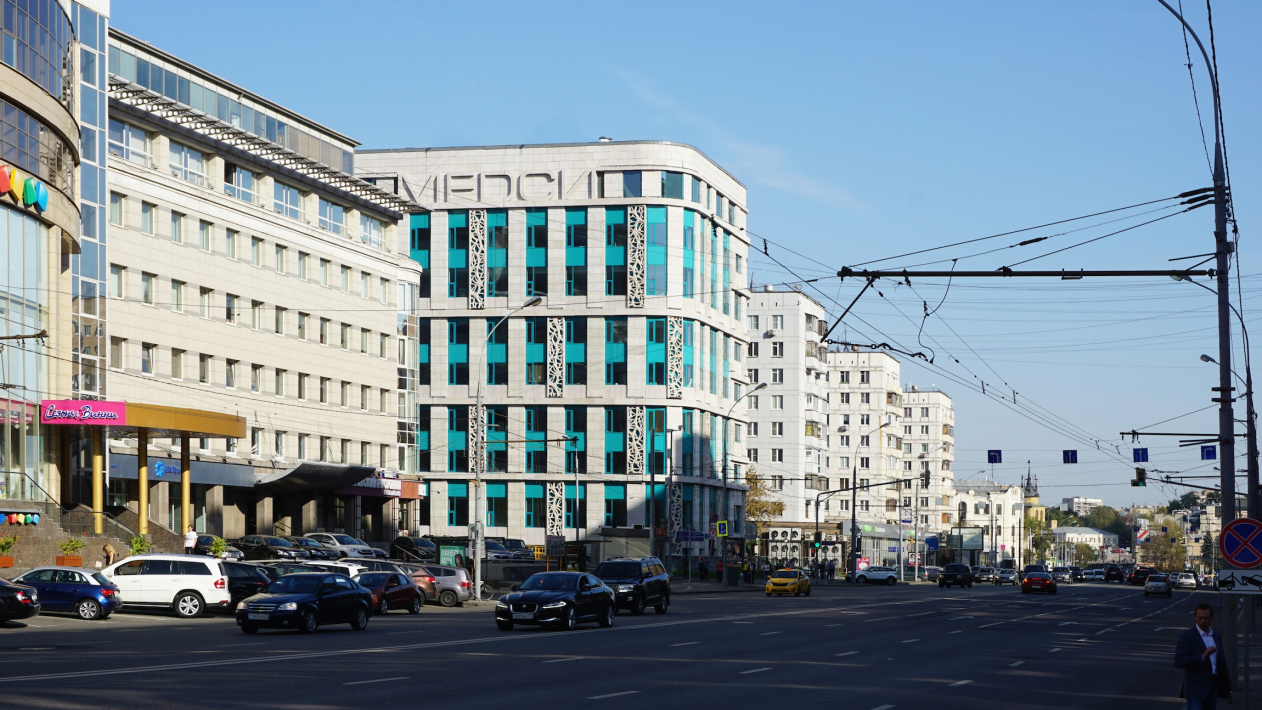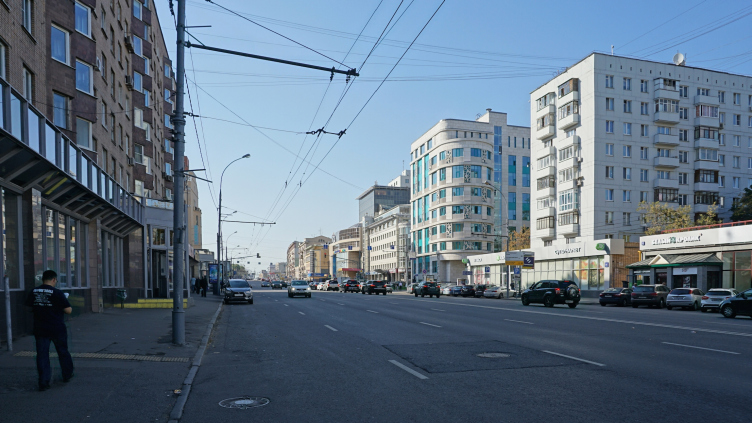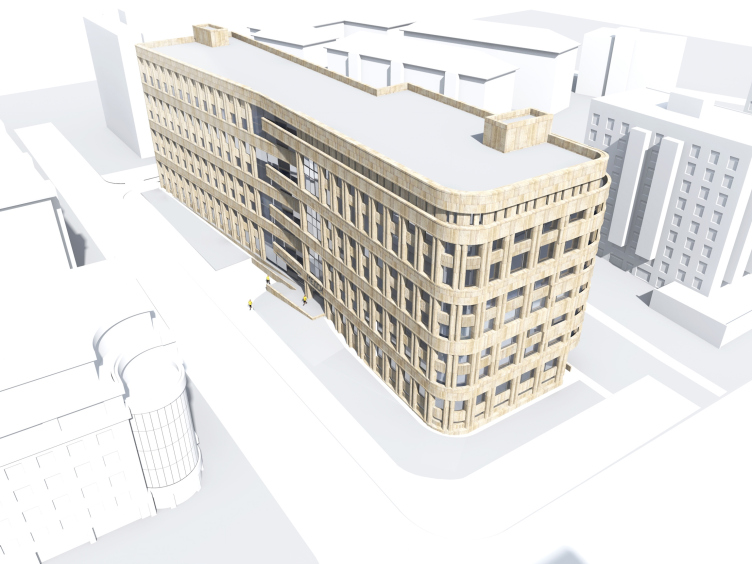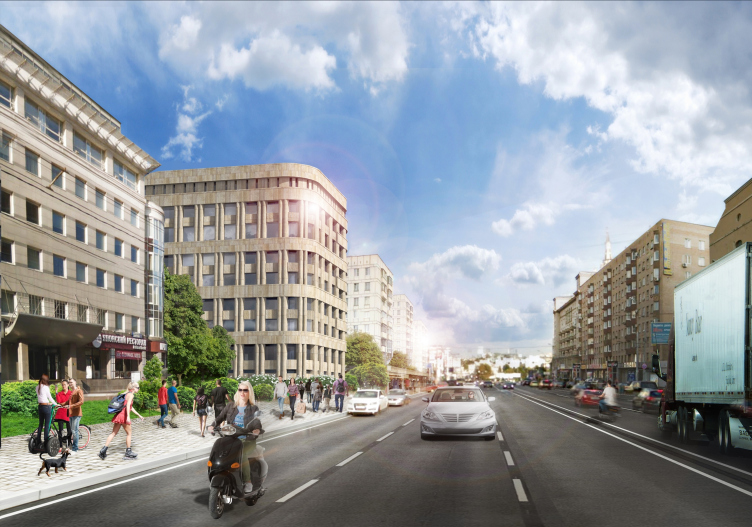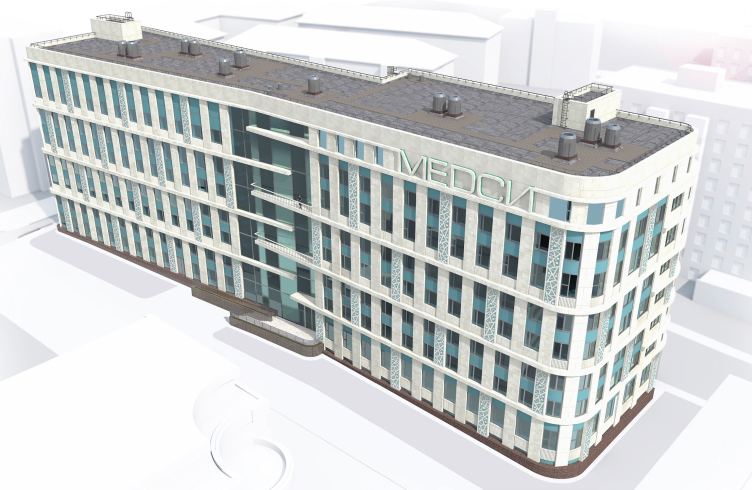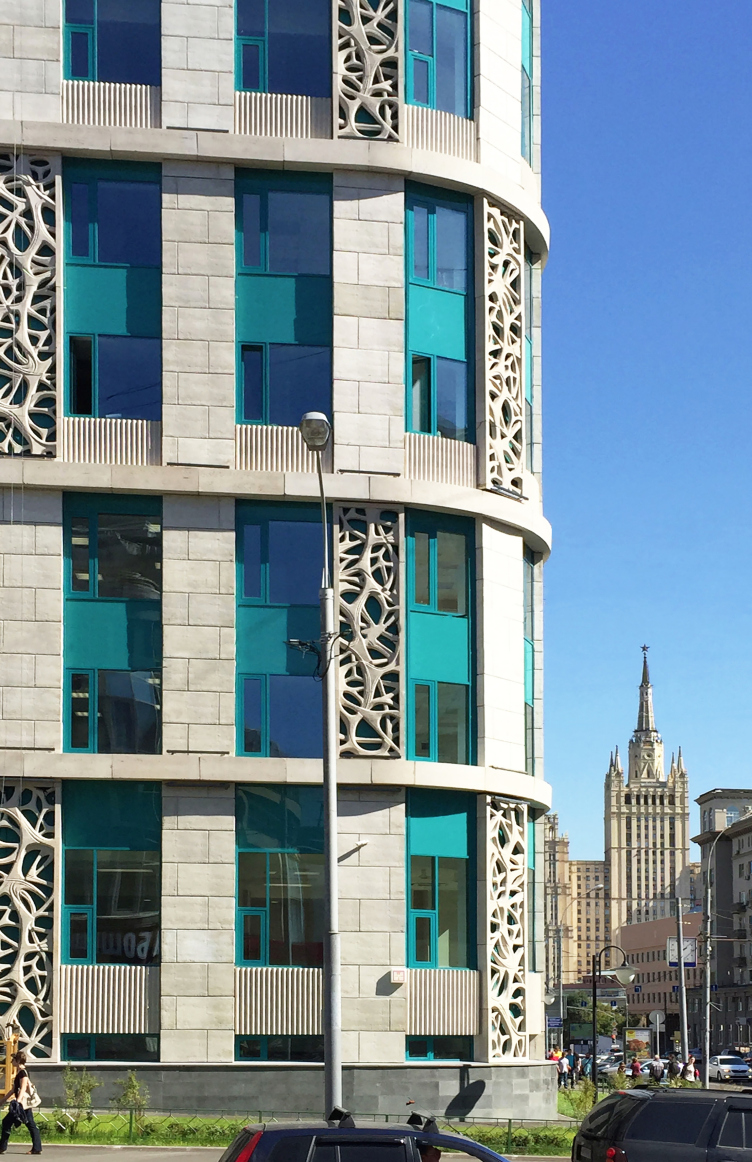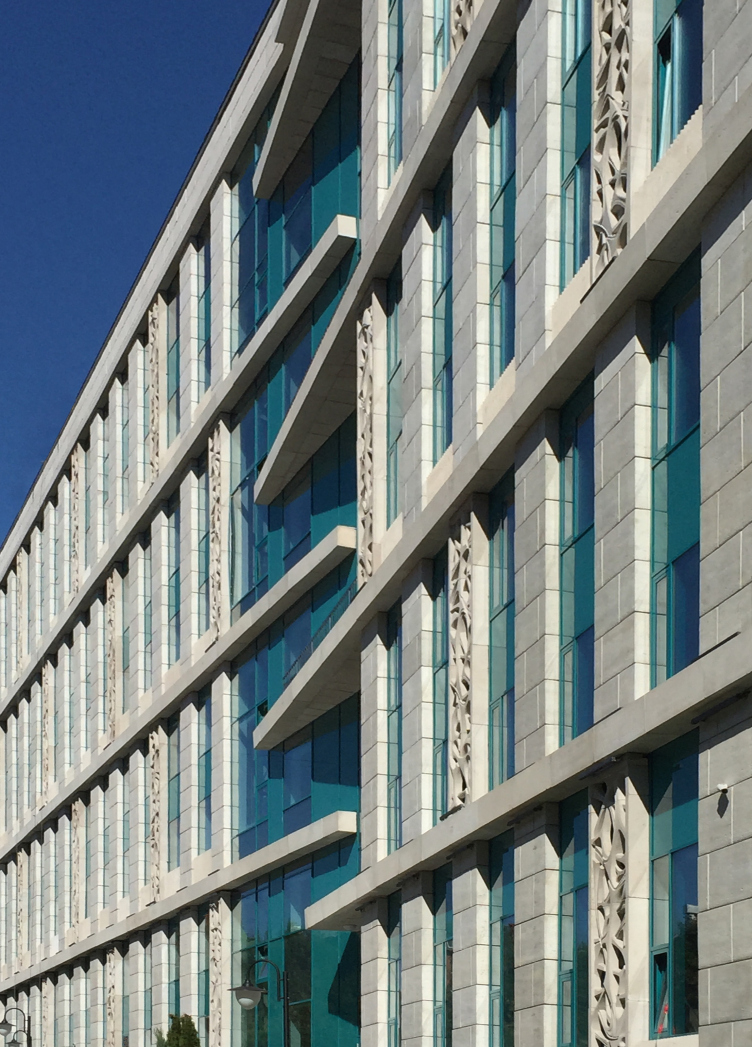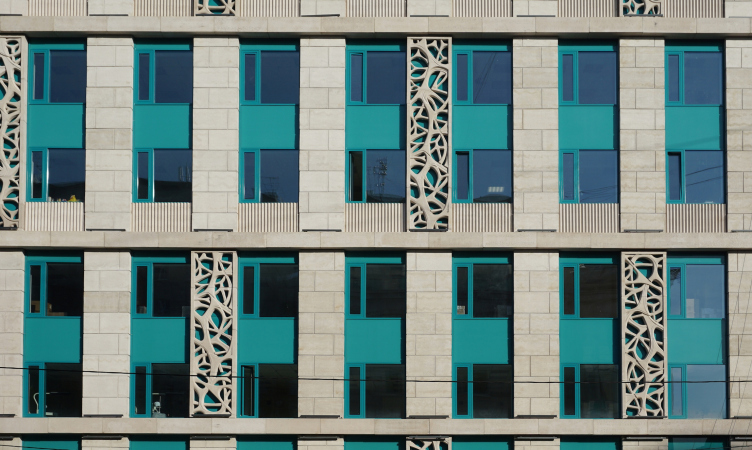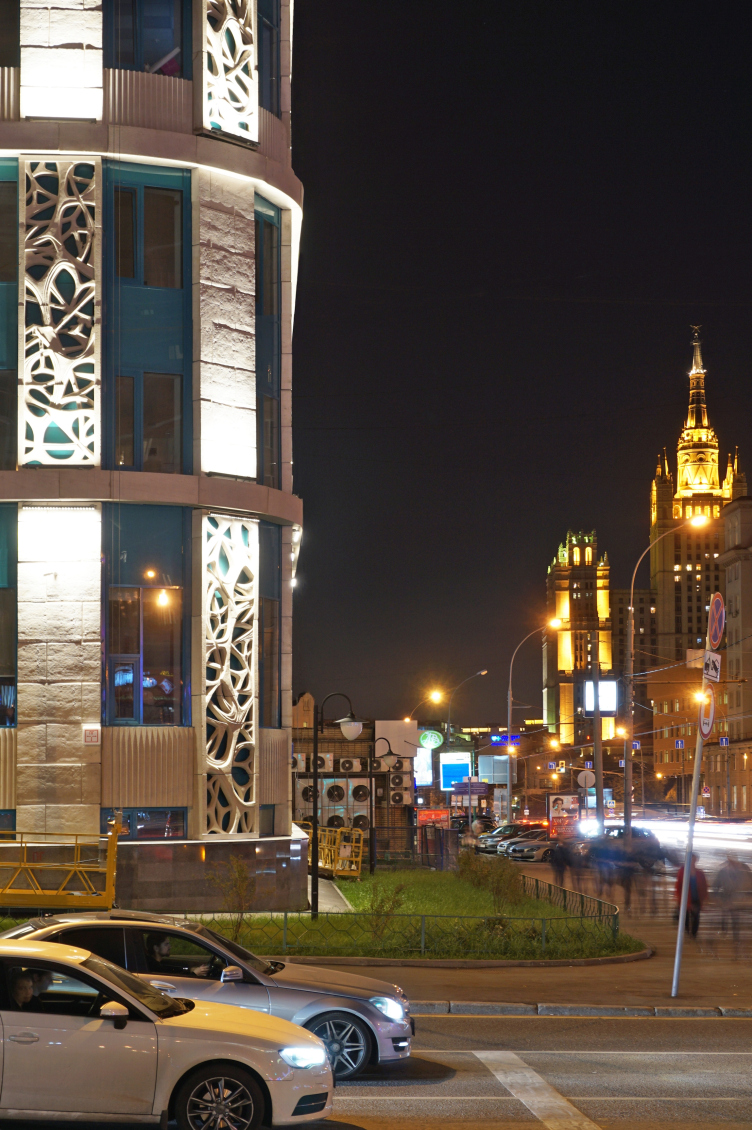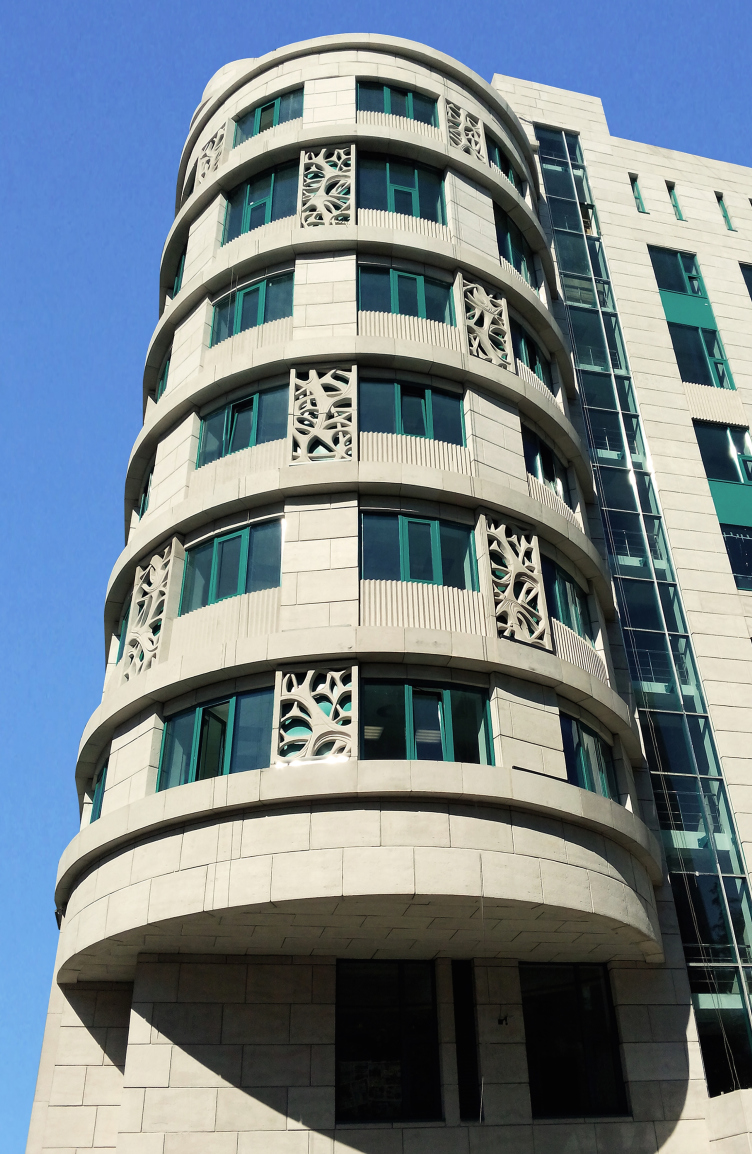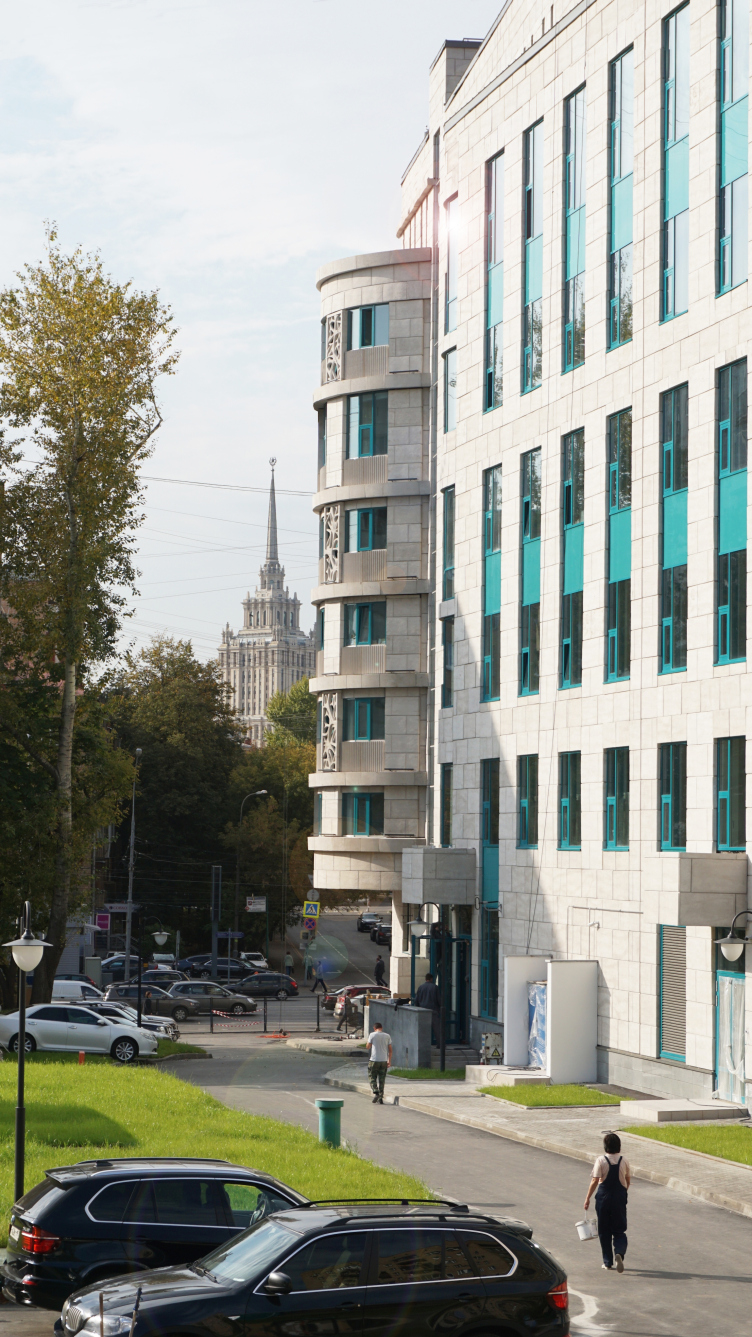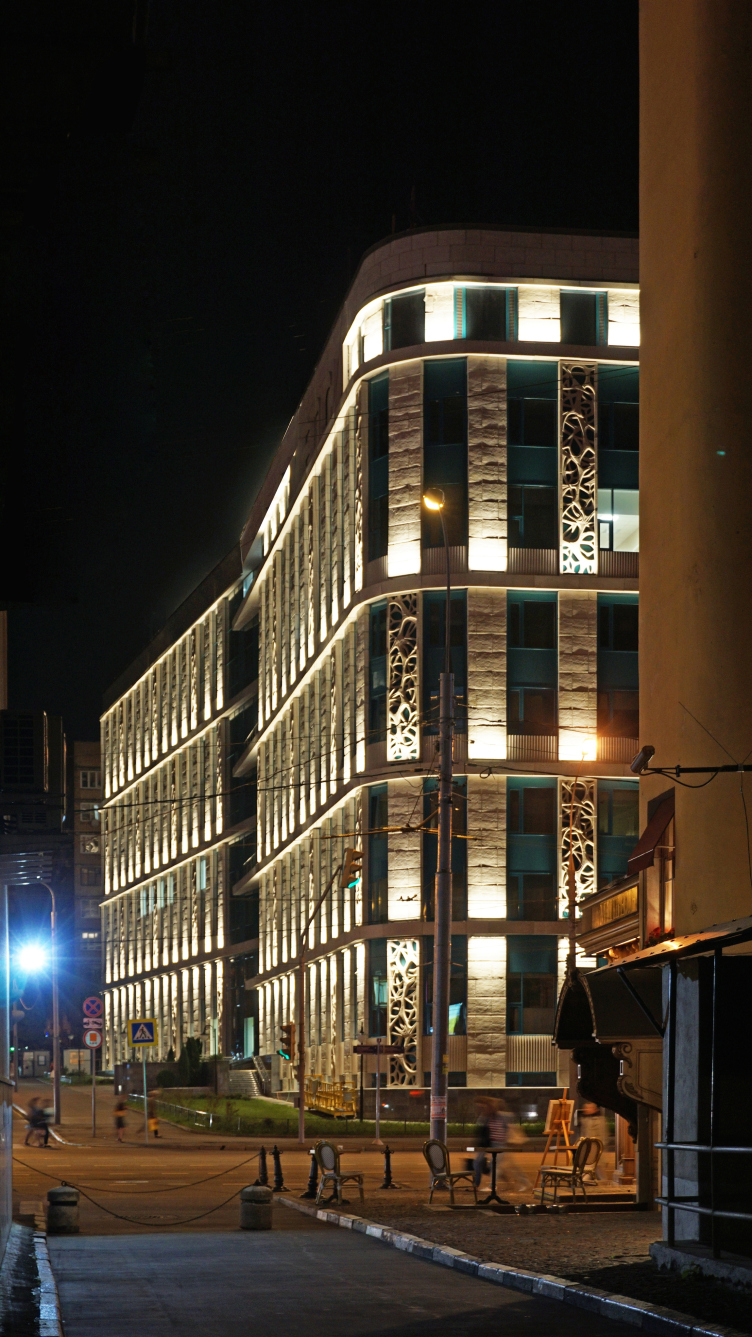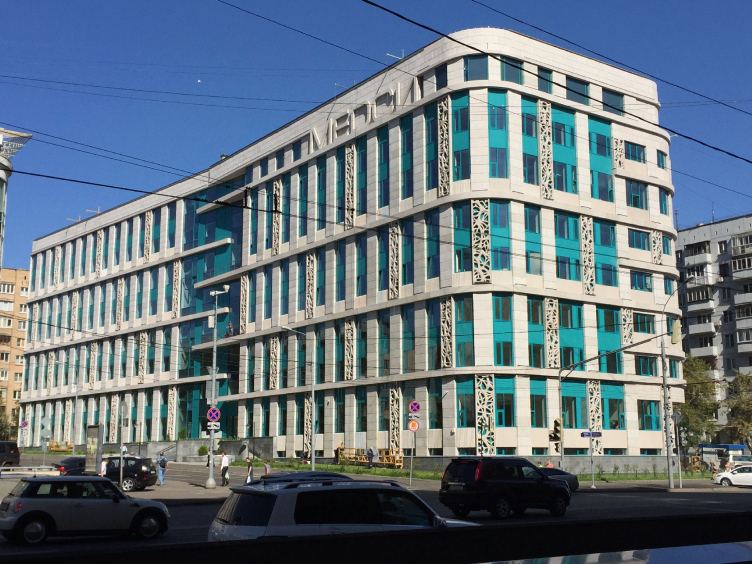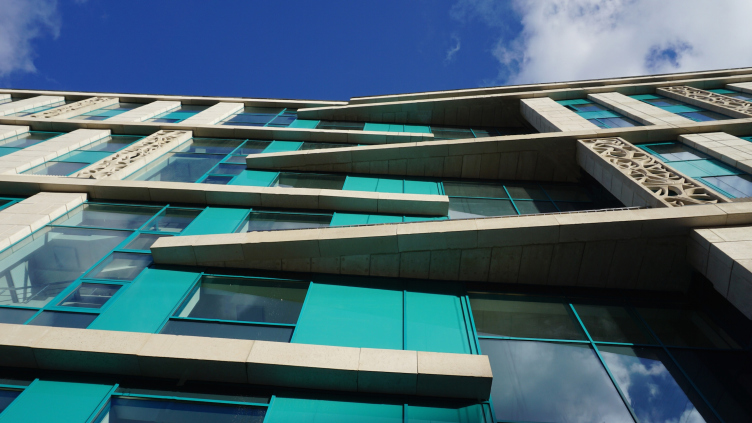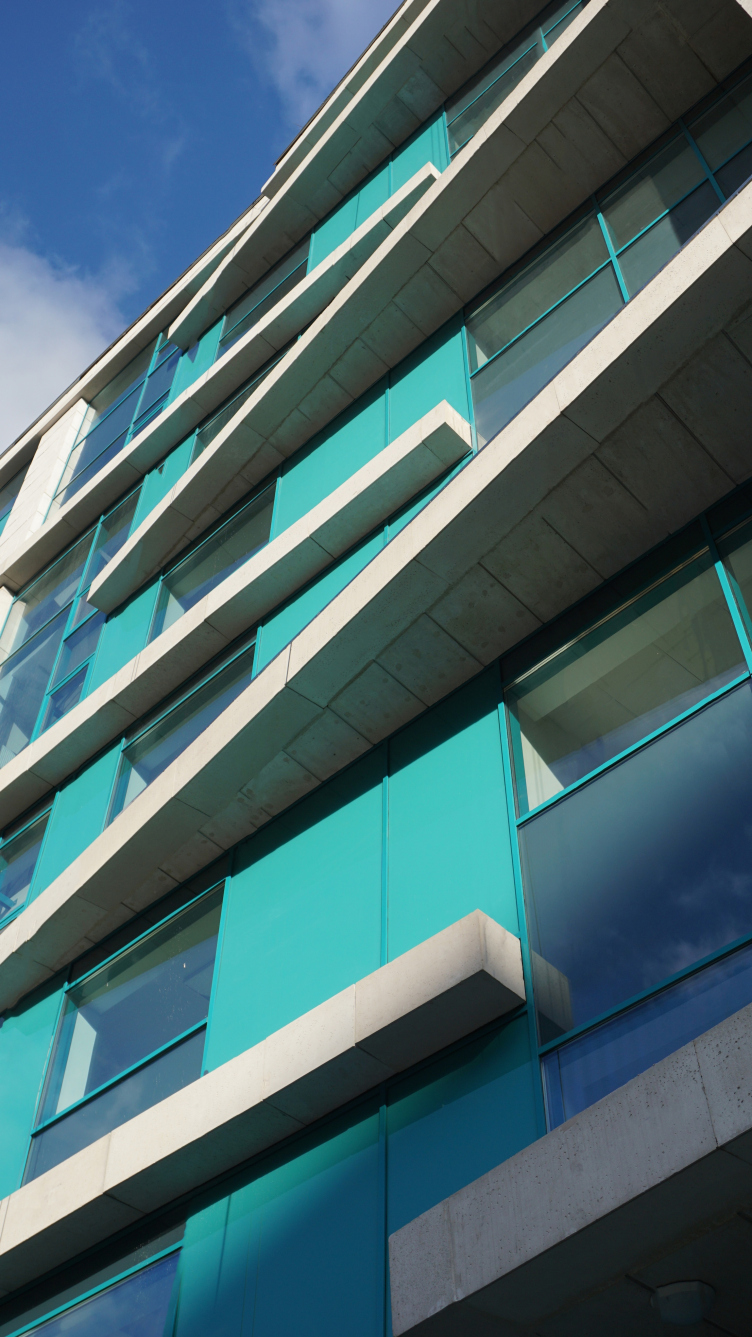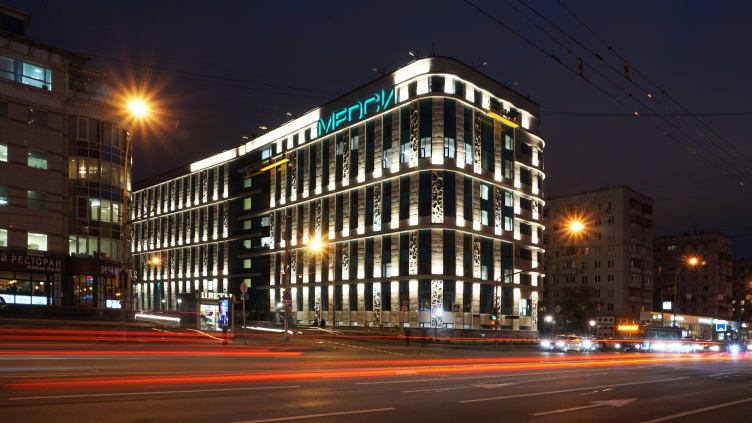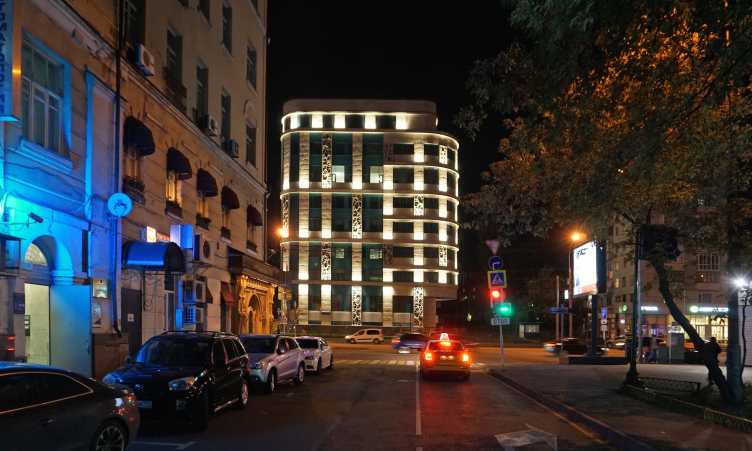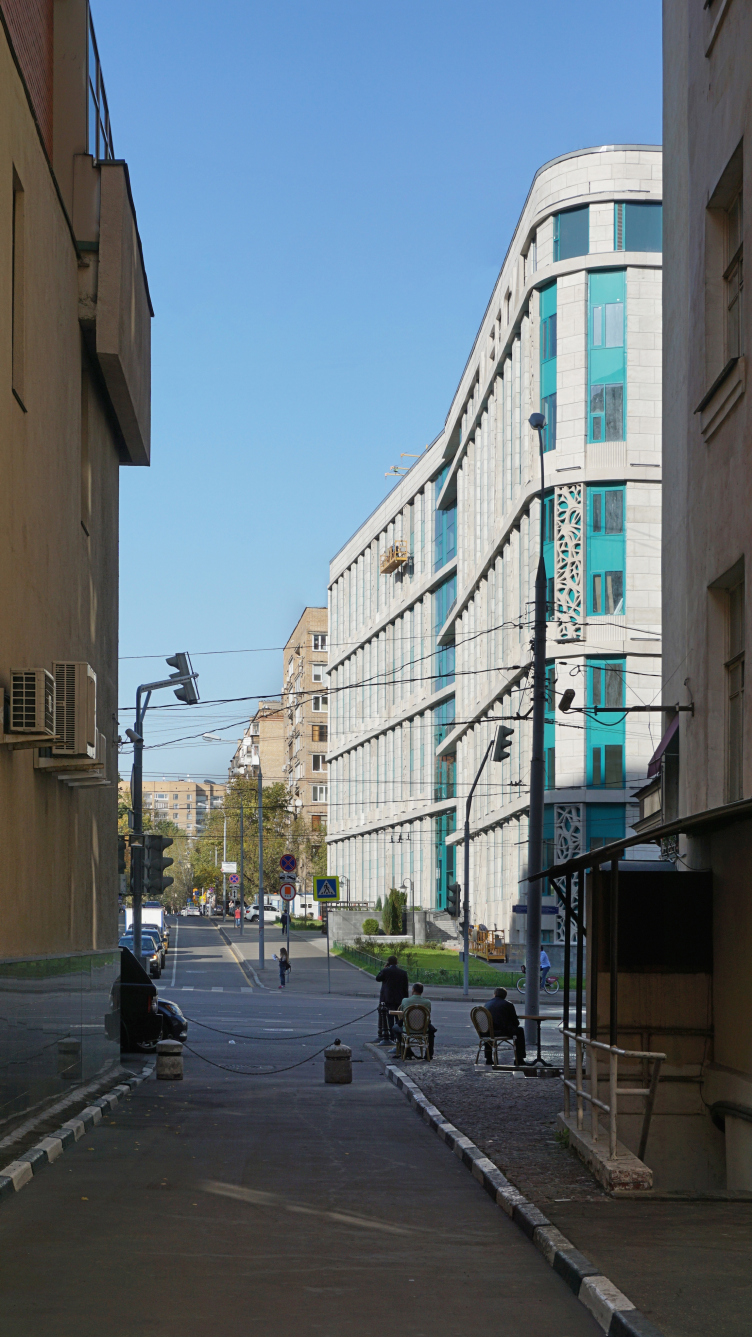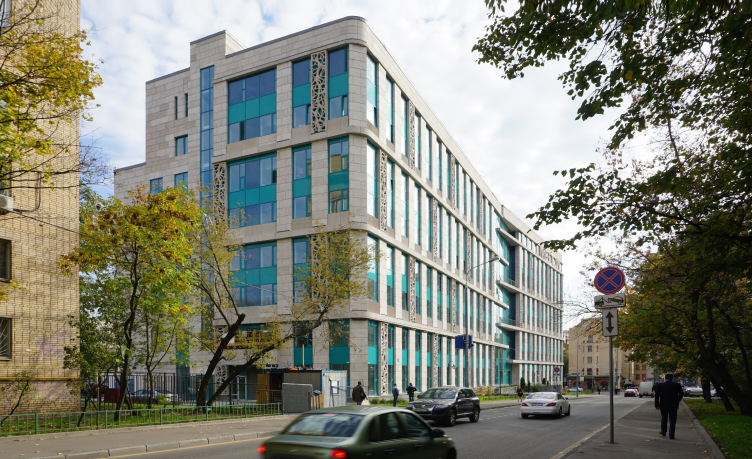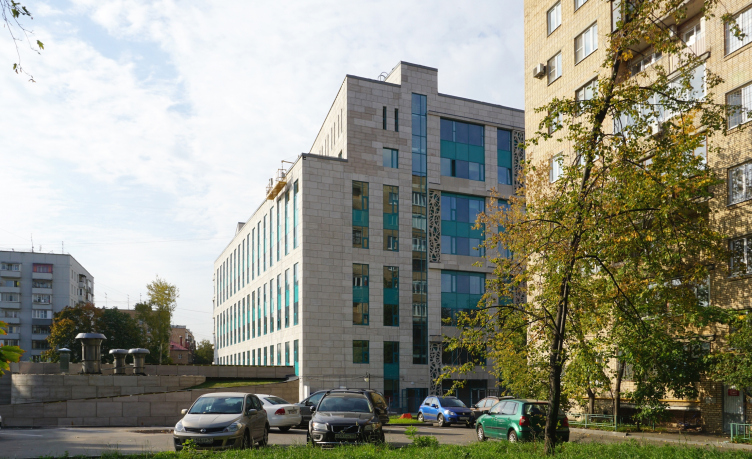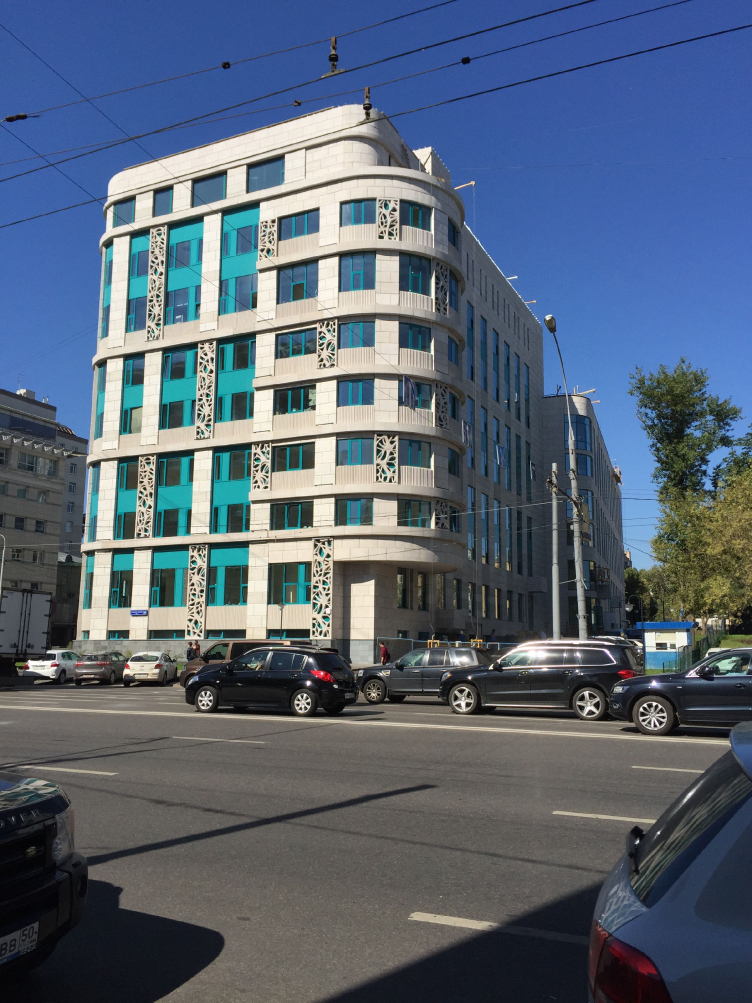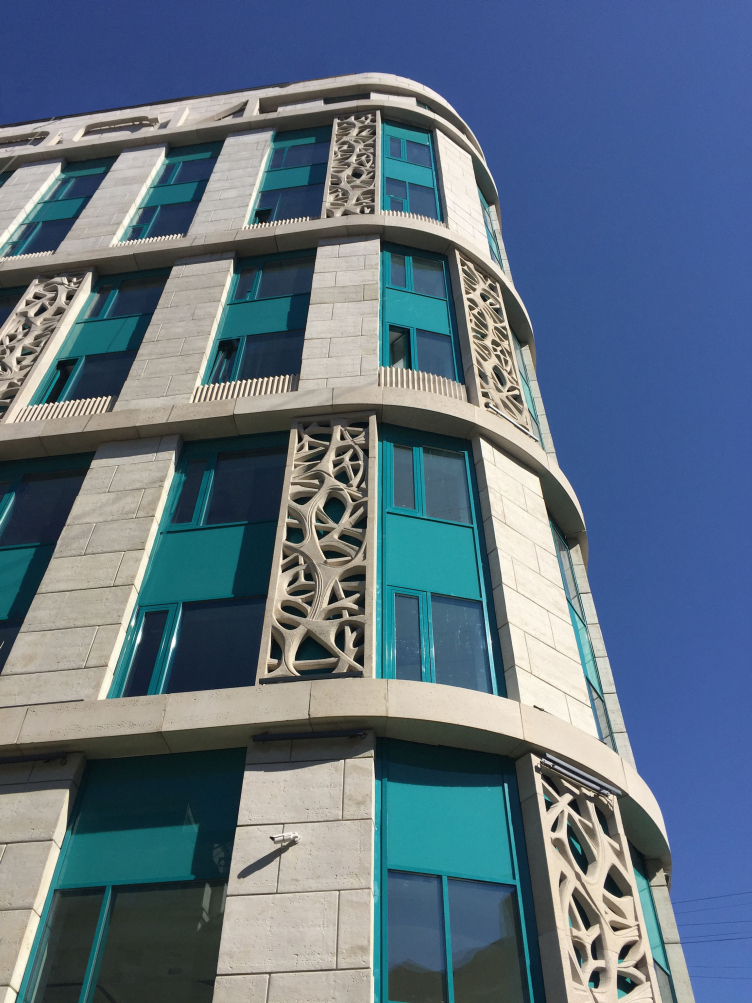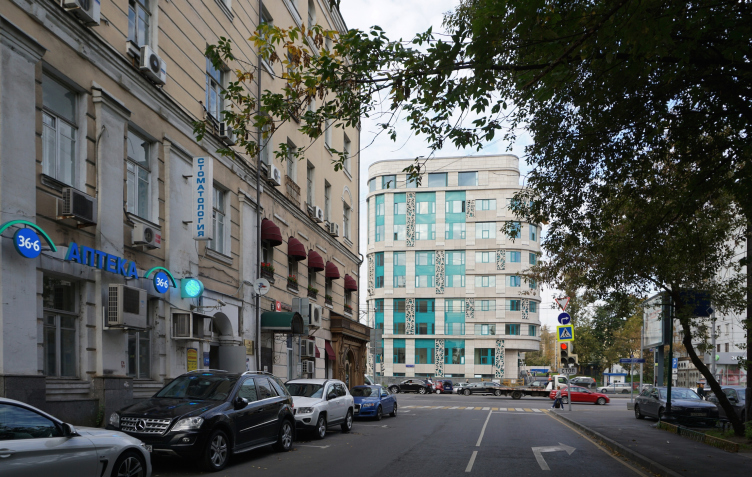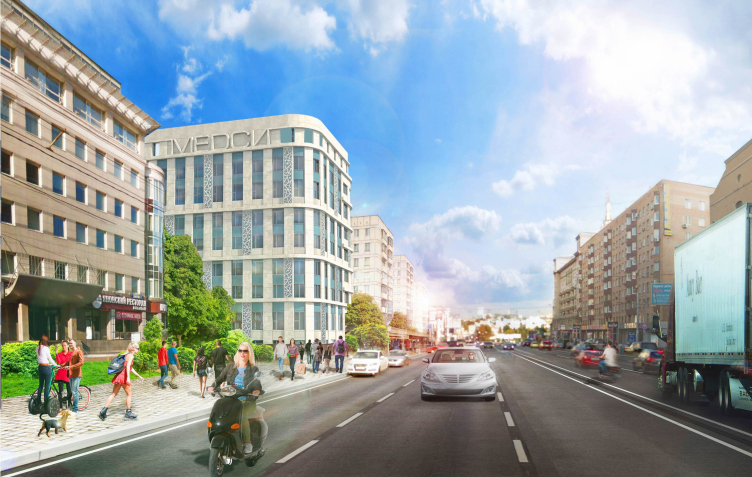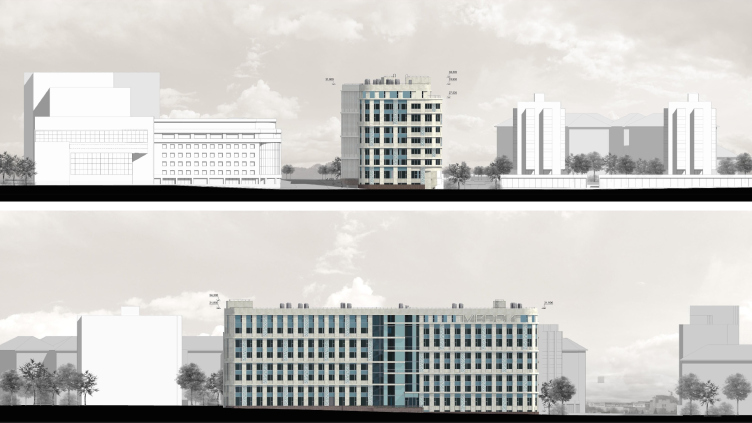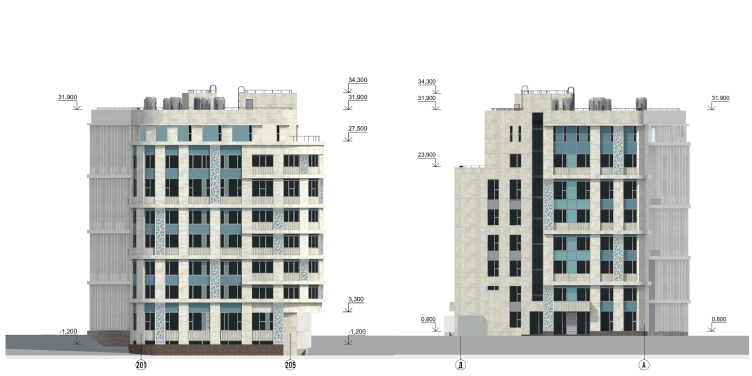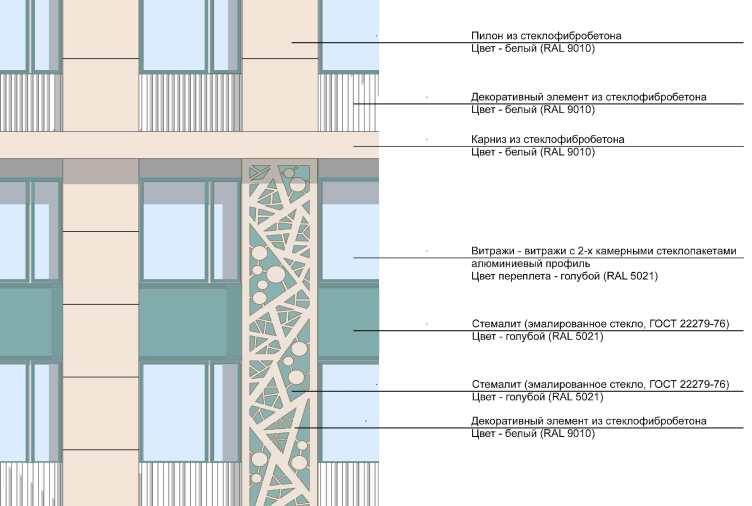The new building of the medical center is situated not far away from the Moscow Zoo and the Krasnaya Presnya high-rise, at the crossing of the Krasnaya Presnya and Malaya Gruzinskaya streets, in the spot of the former "communal kitchen" built in the late twenties by the architect Sergey Kurabtsev. The building of the "kitchen", just like a few adjacent facilities, for a long time belonged to City Hospital №32. Then since 2006 it stood empty gradually falling into decay until in November of 2013, after long negotiations between MEDCI GROUP and Moscow municipality, the controversial decision to take down the old constructivist building was made. Instead, a new state-of-the-art private medical center was built. The customer committed to allot a share of it the city hospital and design the new building in the vein of Soviet constructivism - in memory of its predecessor.
Architectural solution of the facades of the diagnostic and treatment center © GrandProjectCity
Architectural solution of the facades of the diagnostic and treatment center © GrandProjectCity
As the master designer, the company KAPSTROYPROJECT was invited that did the implementation of the project and developed its planning structure. As for the authors of the architecture of this new building, and its facades in particular, they were chosen at a closed contest that included not only Russian but also foreign companies. Karen Saprichyan, the leader of "GrandProjectCity", together with Alexander Asadov, came up with a "compromise" proposal for this contest based on today's interpretation of the motifs of late constructivism. "We wanted to keep the spirit of the place intact - Karen Saprichyan shares - and pay homage to the existing urban environment of Krasnaya Presnya area where construction was underway from the 1930's to 1980's. Today, the most high-profile edifice of this area is the 1928 building of "Gostorg" department store built upon the project of Vesnin brothers. Besides, the style of the late constructivism seemed to us to be the most appropriate for a medical institution: it is in this particular style that, say, the Kremlin health center on the Vozdvizhenka is designed of the Russian Railways health center". The contest was won, and the authors got down to the design work.
In the first version proposed by the architects, the allusions to the late constructivism were rather strong: a rounded bay window overlooking Krasnaya Presnya, large windows and doubled semi-columns, and the horizontal belts of the cornices - all reminded, among other things, the Ivan Fomin buildings. The city council gave the project its approval. The customer, however, did not go for this proposal that was not only approved but also got the "architectural and urban planning solution" certificate: the customer reasoned that the task connected with the quality health care of the new millennium was not to look like the Soviet architecture but, quite the opposite, was to belong to the new age and bring associations with today's technologies. The customer even thought of implementing a different project with fully glazed facades.
Architectural solution of the facades of the diagnostic and treatment center. Project proposal © GrandProjectCity
Architectural solution of the facades of the diagnostic and treatment center. Concept © GrandProjectCity
However, as Karen Saprichyan shares, "thanks to the firm attitude of the main architect of Moscow Sergey Kuznetsov, it was our version that was ultimately chosen, in the spirit of Moscow constructivism". The architecture, however, had to be transformed to a large extent to answer the preferences of MEDCI GROUP. A solution that could satisfy everybody - the city, the customer, the people living in this area that also cared, and the authors as well - was long searched for, in spite of the time constraints, the building had to be built (and actually was built) very quickly - within less than two years, from autumn 2013 to summer 2015.
The second and final version that suited all the parties looks less than the architectural avant-garde and early neoclassic - but the architects added to it some allusions to the "Azure House" on the Leningrad Avenue built by Andrew Burov. We can see here the same concrete grid that stands out from the glass background mounted on metal framework; the difference is that glass is even more abundant here, and the cells of the grid are wider; at some places they unite, as is the custom nowadays, two floors within one cell. We see here the same dominance of verticalls, but here they are spaced more apart and are covered not with imitation Venetian marble as in the Andrew Burov house but with thin rockface panels. Incidentally, the rockface, the blades, and the layered structure of the facade with sunken-in ribbed horizontals are the actually the building's reaction its nearest surroundings; they visually resonate with the Posokhin-Mndoyants Krasnaya Presnya high-rise viewable from here in the perspective.
Architectural solution of the facades of the diagnostic and treatment center. Project proposal © GrandProjectCity
Architectural solution of the facades of the diagnostic and treatment center © GrandProjectCity
Architectural solution of the facades of the diagnostic and treatment center © GrandProjectCity
But the main thing here is the openwork panels. Their pattern is generalized and looks something like gothic spider web with a plastique that is abstract and subjected to the arch-shaped lines, even though still not completely detached from the floral motifs.
The bas-reliefs are executed from sculptural clay full-size: from 3.5 to 8 meters on Karen Saprichyan's author sketches. They were molded and produced also by the team of "GrandProjectCity". "There were many options for these drawings - the author shares: the abstract, echoing the design of the portals of the railroad tracks in the city of Adler, executed by me for the Olympics 2014; floral ornament, simple geometric kind, and others". The openwork reliefs, it must be noted, turned out to be virtually the perfect solution for the problem of reconciling the historical contextualism within the boundaries of which the architects wanted to stay, and the conformity to the expectations of today on which the customer insisted - as is known, probably the "hottest" thing in the architecture of today is the moderately abstract ornament. In other words, the panels made the building look modern and historical at the same time. For the works by the bureau of Karen Saprichyan who is both an architect and a sculptor this solution is also quite characteristic - one can say that in this case the peculiarity of the author's trademark style went a long way to quickly overcome a whole number of contradictions, at the same time endowing the building with a character of its own.
Architectural solution of the facades of the diagnostic and treatment center © GrandProjectCity
Architectural solution of the facades of the diagnostic and treatment center © GrandProjectCity
As far as the overall picture is concerned, the architectural solution is based on the combination of greenish glass - this is MEDCI trademark brand book color which allowed the authors to use this color as an "argument" and to a large degree pushed forward the process of getting the customer's approval - with light stone-looking glass fiber concrete that forms on the facades a textured grid that on the longitudinal facades United the floors into pairs changing its rhythm on the street facade, outlining of the floors. According to the architects, they deliberately varied the different architectural elements using them "to different capacities": in a more reserved way in the yard and more actively at the "visual points of importance" on the street side - this technique was meant to help create the necessary contrast and help form the accents within the framework of a certain homogeneity of the stylistic devices employed.
One of the most noticeable plastic techniques is inherited from the original version - this is a semicircular bay window turned into the direction of the high-rise and hanging in a neat cantilever; the architects deliberately did not stretch it up to the roof level leaving it as a recognizable quotation. The corner at the crossroads side echoes this bay window with a smooth rounding.
Architectural solution of the facades of the diagnostic and treatment center © GrandProjectCity
Architectural solution of the facades of the diagnostic and treatment center © GrandProjectCity
Architectural solution of the facades of the diagnostic and treatment center © GrandProjectCity
The main entrance located in the middle of the slab of the building on the side of the Malaya Gruzinskaya Street, on the other hand, is accentuated by a slight cavity - the facade gets broken in a wide angle resembling an "open book" very much like the New Arbat buildings, even though the resemblance here is less obvious. At the place of the break, the facade gets predominantly glass, while the thin textured interfloor cornices of the left and right parts of the building stop short meeting like clenched fingers of a human hand - in a odd and even formula. Thus, through the difference in the rhythm and the alternation of the two-stores bands, the architects were able to visually break the elongated building into two volumes, as if growing into each other on the pivot of the entrance lobby. On the yard side, there is a cavity in this key place.
Architectural solution of the facades of the diagnostic and treatment center. View from Krasnaya Presnya © GrandProjectCity
Besides, the new building fits in perfectly with the array of the soviet nine-story high-rises at Krasnaya Presnya - its tallness and color make it look like it really belongs here.
An important part in creating the individual image of the building is played by the architectural backlighting that helps to reveal the structure of the facades and enhance the individuality of the plastic techniques. The openwork panels got a special "bonus" - RGB backlight in the full color range; it delicately accentuates the inserts without violating the integrity of the facade structure.
The complex at the Krasnaya Presnya was built really fast, in spite of the complexity of the land site and the issues having to do with the demolition of the old building. The construction began in 2014, and as early as before 2016 the center should open for the patients. The clinic will cover all the medical branches from general therapy to immunology and allergy research. The clinic will also include the day patient facility, the operational, and the diagnostic block. For the nation's capital, this is a great step in the development of its health care system, however payable, while for the city environment it is something like a vitamin injection, an example of almost literal "alloy" of reflections of the days past with the new ideas of tomorrow.
Architectural solution of the facades of the diagnostic and treatment center © GrandProjectCity
Architectural solution of the facades of the diagnostic and treatment center © GrandProjectCity
Architectural solution of the facades of the diagnostic and treatment center © GrandProjectCity
Architectural solution of the facades of the diagnostic and treatment center © GrandProjectCity
Architectural solution of the facades of the diagnostic and treatment center © GrandProjectCity
Architectural solution of the facades of the diagnostic and treatment center © GrandProjectCity
Architectural solution of the facades of the diagnostic and treatment center © GrandProjectCity
Architectural solution of the facades of the diagnostic and treatment center. Concept © GrandProjectCity
Architectural solution of the facades of the diagnostic and treatment center. Facades © GrandProjectCity
Architectural solution of the facades of the diagnostic and treatment center. Facade © GrandProjectCity
Architectural solution of the facades of the diagnostic and treatment center. Fragment of the facade with the marks of finishing materials © GrandProjectCity

